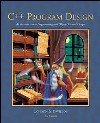 |  C++ Program Design, 3/e James P. Cohoon,
University of Virginia
Jack W. Davidson,
University of Virginia
Computing and the object-oriented design methodology
Chapter 1 Overview| Computers are an integral part of life in the new millennium. For example,
most of us have surfed the World Wide Web. Computers are also being used in
ways that are not as obvious. For example, every time you use your telephone,
it likely connects to a computer system. Similarly, on your next plane trip, it
may be that the aircraft is landed by a computer system and not the pilot! The
term computer system is used to emphasize that there are two distinct
components: hardware and software. The hardware is the computer itself. The
software is the programs that tell the computer what to do. In the telephone
system example above, it is the software that provides special features such as
call waiting. Designing and building software is especially challenging today,
when a piece of software may consist of millions of lines of code. In recent
years, the object-oriented programming design methodology has emerged and
shown much promise for managing and coping with such complexity. In this
chapter, we introduce basic computing terminology and the concepts behind
object-oriented design. In successive chapters, we show how to design and
write software using the object-oriented programming language C++. |
|



 2002 McGraw-Hill Higher Education
2002 McGraw-Hill Higher Education